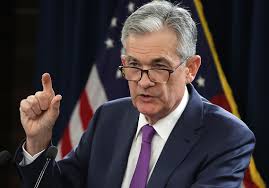Fra BNP Paribas:
KEY MESSAGES
We expect the FOMC to cut rates 25bp at its
September meeting, downgrade its economic
forecasts, and project lower rates through 2021.
We see the “dot” plot as a centerpiece of the
Committee’s formal communication of an easing bias,
albeit one with a path that remains substantially
shallower than market pricing. Chair Powell will have
the challenge of squaring the two at the press
conference.
We see the FOMC ultimately cutting rates by a further
100bp through June 2020, as an expected downturn
in growth over the next several quarters compels it to
ease policy beyond precautionary considerations.
The Committee has repeatedly pointed to the trio of
1) trade developments, 2) global growth, and 3)
muted inflationary pressure as justification towards
acting as appropriate to sustain the current
expansion (ie, easing).
Since both the June and July meetings, conditions on
both the trade and global growth fronts have
worsened, with Trump announcing a litany of fresh
tariffs on 1 August and German growth contracting in
Q2 (though tentative signs of a limited US-China
ceasefire have emerged).
On the domestic side, manufacturing has weakened
further. Though services and consumer spending
have held up, the trend in hiring has continued to
soften. And while spot inflation has picked up over
the past three months, inflation expectations remain
low.
Still, the degree of easing necessitated by the
Committee’s above commitment, current conditions,
and the constellation of risks is unclear. And unlike
when it was using the “dots” to project the pace of
raising rates towards neutral, the FOMC will now be
using the “dots” to show the degree of projected
accommodation amidst this uncertain environment.
Using the “dots” to show an easing bias: Given an
overall deteriorating trade and growth picture, we think
the FOMC will continue to project a more accommodative
path, even with spot rates likely 50bp lower than in June.
At the same time, we consider it unlikely that the
Committee will project a path as accommodative as the
market is currently pricing, which as of 13 September
was for about 80bp further easing by end-2020, which
would translate to 55bp of further easing accounting for a
likely September cut (see Fig. 3).
Financial conditions have remained accommodative after
tightening into the beginning of the year (see Fig. 4). The
FOMC has appeared to become increasingly sensitive to
such accommodation, both by 1) citing it as a key factor
underpinning its relatively benign growth outlook, and 2)
recognizing market expectations for further policy easing
as underpinning it (see US FOMC: Dovish self
awareness and US FOMC: Thread the needle, set the
stage).
The challenge for the Committee via the “dots” is
how to retain enough of an easing bias to hold
current market expectations (and hence financial
conditions) steady without explicitly committing to
them and thereby losing optionality.
We think the Committee will attempt to do so through
both the “dots” and the Chair’s press conference. On the
“dots” side, we expect the median 2020 “dot” to continue
to project an additional cut, even with end-2019 rates
50bp lower than in June.
Additionally, we see the 2021 median “dot” showing a
pause, a change from the June median projecting a hike,
which we expect the median Committee projection to
delay until 2022 (the September FOMC will be the first
meeting to show 2022 forecasts).
Even with an expectation of a 12.5bp lower median
neutral rate estimate (Minneapolis Fed President
Kashkari has hinted at moving his neutral rate estimate
down, and overall persistently lower longer-end yields
may weigh on other participants’ estimates), this would
leave rates in accommodative territory – by a full 50bp –
through end-2022.
Threading the needle: Still, this path would leave
projected rates above current market expectations, likely
requiring Chair Powell to reconcile the difference to avoid
tightening financial conditions.
The major difference between the FOMC’s expected rate
path and market pricing (and our own forecast for 100bp
of cuts by June 2020) is likely divergent outlooks for the
economy.








